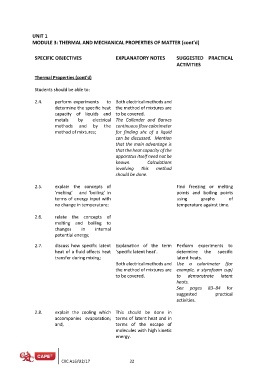Page 532 - SUBSEC October 2017_Neat
P. 532
UNIT 1
MODULE 3: THERMAL AND MECHANICAL PROPERTIES OF MATTER (cont’d)
SPECIFIC OBJECTIVES EXPLANATORY NOTES SUGGESTED PRACTICAL
ACTIVITIES
Thermal Properties (cont’d)
Students should be able to:
2.4. perform experiments to Both electrical methods and
determine the specific heat the method of mixtures are
capacity of liquids and to be covered.
metals by electrical The Callender and Barnes
methods and by the continuous flow calorimeter
method of mixtures; for finding shc of a liquid
can be discussed. Mention
that the main advantage is
that the heat capacity of the
apparatus itself need not be
known. Calculations
involving this method
should be done.
2.5. explain the concepts of Find freezing or melting
‘melting’ and ‘boiling’ in points and boiling points
terms of energy input with using graphs of
no change in temperature; temperature against time.
2.6. relate the concepts of
melting and boiling to
changes in internal
potential energy;
2.7. discuss how specific latent Explanation of the term Perform experiments to
heat of a fluid affects heat ‘specific latent heat’. determine the specific
transfer during mixing; latent heats.
Both electrical methods and Use a calorimeter (for
the method of mixtures are example, a styrofoam cup)
to be covered. to demonstrate latent
heats.
See pages 83–84 for
suggested practical
activities.
2.8. explain the cooling which This should be done in
accompanies evaporation; terms of latent heat and in
and, terms of the escape of
molecules with high kinetic
energy.
CXC A16/U2/17 32

